Menus
- The faithful friend
- 4 Z1000 cylinders rebored to 1,229 cm3, 144 hp, Moto Martin frame, 175 kg dry
- Discovery
- In the saddle
- Test
- Conclusion
The faithful friend
4 Z1000 cylinders rebored to 1,229 cm3, 144 hp, Moto Martin frame, 175 kg dry
Many of us have had motorcycles that have become family, loyal friends that are remembered for a long time and that end up becoming a part of your life.. This is the case with the Motorcycle Martin Kawasaki that Australian Scott Webster has had in his garage for the past four decades, not just to grab the baguette on Sundays but to run with it. Another important point, he lives a few kilometers from the Phillip Island circuit. It was a sign! He still races today on his handlebars and successfully in the Forgottent Era 5 category of the Post-Classic, the Vintage Superbike for the rest of us, so much so that he has been a regular contender for victory against stars of yesteryear such as Wayne Gardner, Jeremy McWilliams, Rob Phillis, Steve Martin and Mal Campbell !
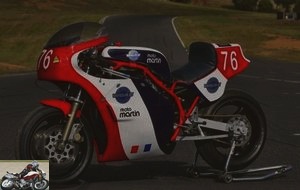 Test of the Martin Kawasaki 1230 Motorcycle
Test of the Martin Kawasaki 1230 Motorcycle
Discovery
Although his job as a self-employed car electrician has never made Scott more than a part-time Superbike rider, he has been racing nonstop since 1982 and at the highest level since 1985 in Australian Superbike. Webster even took part in several local World Superbike events in the 1990s and came out with top honors in his self-prepared Honda RC45. But it was not until 2004, when he was persuaded to bring the Moto Martin out of retirement and prepare this former endurance sportswoman for the Forgotten Era which was starting to gain importance, that the Australian became a regular at the outposts. In doing so, he brought more honors on the track to the brand than anyone before since the creation of the French frame manufacturer Moto Martin in 1972. Because at the time, Georges Martin’s sports cars were focused for the road and mainly served to fill the endurance grids with private machines, but without any significant success gleaned.
 Scott Webster on the Moto Martin
Scott Webster on the Moto Martin
However, Scott owns the Moto Martin, resplendent in its Gallic livery with the tricolor flag on each side of the fairing since 1983. This makes it part of the Webster family team which includes his partner Annie and their children, as well as his father Bob.
The bike was imported in 1980 by Melbourne-based Australian Moto Martin agent, Frenchman Bertrand Cadart. His company La Parisienne then installed a Kawasaki Z1000 engine there, prepared to replace that of Honda CB900FZ in the double-cradle perimeter frame that was originally designed to house it. The result was entered in the Arai 500 endurance race in 1981 in Bathurst for Scott Stephens and Dave Miller. Unfortunately, they did not finish the race and the running frame was loaned to the late Ken Wooton. The latter installed his own Superbike Z1000J engine there and then piloted it with Dave Shaw in the 1982 Arai 500. The result was another abandonment. Cadart then sold the Moto Martin bare chassis in 1983 to Scott Webster who had just started racing a year earlier. Scott then rebuilt the sports car with a French frame and ran with it for a year, quickly climbing the ranks. But once he arrived at the Superbike in 1985, he had to put it in the garage, the category having been limited to 750 cm3.
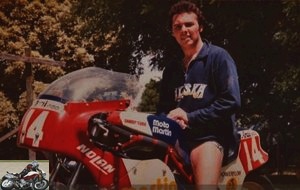 Scott Webster with the Martin Kawasaki Motorcycle in 1987
Scott Webster with the Martin Kawasaki Motorcycle in 1987
Scott webster :
I could have sold it. But I had enough to buy a Suzuki GSX750H and ride it without needing the money from the sale of the Moto Martin. I was attached to it and even more after having totally rebuilt it myself. So I decided to keep it. And during the next 20 years during which I rode in Australian Superbike, it was an element of the decorations in the garage, without ever being useful. But a friend said to me "take this bike and use it, let’s go racing in Forgotten Era". I had already thought about it, but the regulations said that it had to be a double shock absorber motorcycle and my motorcycle only has one properly speaking. But between the lines it was authorized, on the grounds that it was not a link or rocker suspension, even if it only had a shock absorber. So I did some shopping and thought to myself "damn it is super fun and there are some really good guys out there. From there I decided to take it more seriously, I installed some 17 "wheels to use modern tires and I asked Trevor Birrell to tune the engine. Things evolved from there and we started to ride ahead. But other than the wheels and the faster engine, it’s still the same bike I’ve had for all these years. She just got a new life, just like her pilot! "
Indeed, because after finishing third in the historic championship for his first season on the motorcycle, Webster has become a recurring leader in the category..
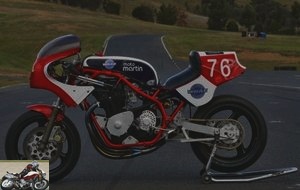 The Martin Kawasaki 1230 Motorcycle without fairing
The Martin Kawasaki 1230 Motorcycle without fairing
The chance to ride the Moto Martin presented itself on the narrow 2.16km track at Broadford, north of Melbourne, where the many slow corners and drops provide a pretty severe test for a long wheelbase motorcycle. more at ease on fluid and fast tracks like Phillip Island, where at the time Bathurst. Especially when the impressive power of 144 horsepower at 9,200 rpm that tuner Trevor Birrel has managed to extract from the 1.229 cc Kawasaki 4-cylinder is transmitted through the meager rear wheel of 4.50 ", the maximum width allowed by the regulations. At least Motorcycling Australia executives are allowing slick tires to boost horsepower to the limit of 1,300cc. This pushes tuners to go further with engine upgrades, adding to the show while removing concerns about the engine. need to measure the overbore one liter engines that proliferate in the category.
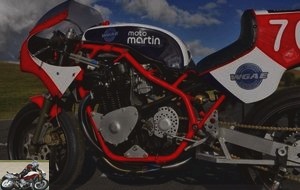 The Moto Martin frame was originally cut for the Honda CB900FZ engine.
The Moto Martin frame was originally cut for the Honda CB900FZ engine.
And making it bigger is exactly what Trevor Birrel did by taking a set of Z1000J crankcases with a standard welded and closed oil pan. He then pushed the original engine dimensions from 69.4 x 66 mm (998 cm3) to 77 x 66 mm for 1,229 cm3 using Arias 11: 1 compression pistons, mounted on stock connecting rods installed on a GPZ1100 crankshaft. The larger bore GPZ 1100 cylinder block has been further reamed and perfected with the Z1000J cylinder head completely reworked by Birrell, 11 times South Australian Pro-Stock Drag Champion. Birrell’s work resulted in a new form of combustion chamber. Then he carried over and re-fed the cylinder head, then installed oversized Ferrea steel valves, a 38mm intake and a 32.5mm exhaust, one pair per cylinder, each with two springs. Double overhead camshafts are the 390 version of Web-Cam, chain operated with a slipper type tensioner. The engine life is ten hours of operation between each check and over the past decade the Birrell engine has proven to be ultra-reliable on the Moto Martin with no mechanical abandonment in 13 years of racing. We touch wood…
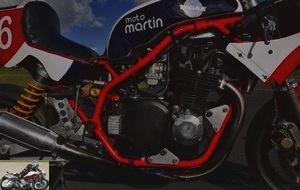 The Z1000 engine has been bored to 1,229 cm3 to deliver 144 hp
The Z1000 engine has been bored to 1,229 cm3 to deliver 144 hp
Breathing is provided by four 33mm Keihin CR carburetors and a Moriwaki Monster 4-1 racing line with aluminum and titanium mufflers. Ignition is provided by a self-powered PVL CDI with two adjustable advance curves, allowing Scoot to compose a new map via a laptop computer if needed while the rev limiter is set to 9,500 rpm. The transmission has been upgraded to handle the excess power with a 5-speed GPZ 1100 gearbox paired with a ZXR750 slip clutch with heavier springs.
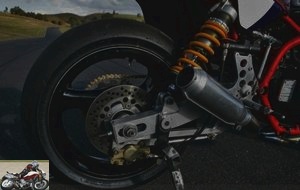 The bike receives a Moriwaki Monster 4-1 exhaust system
The bike receives a Moriwaki Monster 4-1 exhaust system
This torquey motor is rigidly mounted in the Moto Martin double-cradle perimeter frame in tubular CrMo steel and bearing the BDK No. 2088. Unlike most of the French manufacturer’s creations, the frame has never been nickel-plated; it was an option that Georges Martin considered manifestly inappropriate on the endurance sports car sent to his Australian importer! On the other hand, it wears the original 38mm Marzocchi fork, with modified internal components, set to a closed caster angle of 25 ° but not adjustable, not even in preload. At the rear, the rectangular-section aluminum swingarm is combined with a fully adjustable Ohlins shock absorber with separate reservoir. This is mounted vertically on the right, as on a dual shock configuration. Looks like Mister Martin just removed the left shock to turn the frame into a single shock design, but the setup doesn’t cause any ill effects to the swingarm..
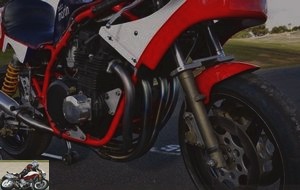 If the 38 mm Marzocchi fork remains original, its components have been revised
If the 38 mm Marzocchi fork remains original, its components have been revised
Like many other Forgotten Eura riders, Webster fitted 17 inch wheels to be able to use modern Dunlop slick tires with a 3.50 "cast aluminum Marvic rim at the front shod with a KR106 125/80 and mounted with two 310mm Honda discs gripped by Brembo Serie Oro two piston calipers. At the rear is a much heavier 4.50 "Suzuki GSX1100K rim carrying a Dunlop KR108 165 / 55-17. The 200mm rear disc is also from the GSX, but remains purely decorative since Scott never uses this other Brembo 2 piston caliper..
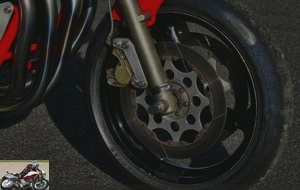 The front brake consists of two Honda discs and Brembo Serie Oro calipers
The front brake consists of two Honda discs and Brembo Serie Oro calipers
The dry weight is 175 kg and the wheelbase is 1,520 mm. What makes the Moto Martin a difficult machine to take on a tight circuit, like Broadford, with the engine placed high, but allows to take more angle thanks to the more important ground clearance and thus to take advantage of it in fast curves.
In the saddle
Climbing aboard the Moto Martin, you are more likely to sit than perched stuck in the padded high-back saddle with the large 24-liter aluminum fuel tank to lean on in the straights when cruising. we hide behind the efficient full fairing. The Moto Martin must indeed be a very good machine for the Phillip Island fast track..
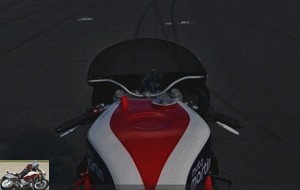 The driving position is typical of endurance sports cars of the 70s
The driving position is typical of endurance sports cars of the 70s
Someone taller than Scott like me finds themselves slightly cramped with the raised footrests which provide extra leverage to move the bike when it was impossible for me to do so. This is a typical stance of endurance machines of the 1970s when riders weren’t supposed to move all around the bike or take a lot of angle with the meager tires that were poor grip but durable at the time. Changing the rear tire in a 24 hour race was considered a problem! One only has to look at photos of a 1970s endurance race to see the riders all sitting firmly in the center of their single-seater saddles as they lean the bike side to side focusing on the fact. that to finish first, you have to finish already.
Test
But the modern Forgotten Era races are the exact opposite. In this game, the Moto Martin is surprisingly agile due to the enormous ground clearance. You get to the edge of the tire before anything hits the ground, aided by steering that is both smooth and precise. This allows you to go on the same trajectory lap after lap, taking as much angle as you dare without asking too much of the front Dunlop or the rather basic Marzocchi fork which was, I’m sure, responsible for the dribbling as I started to feel the faster turns in Broadford once I picked up the pace. Scott agrees on the "primitive" aspect of the nose gear, but explains that the test of a CBR600 fork that everyone uses was inconclusive..
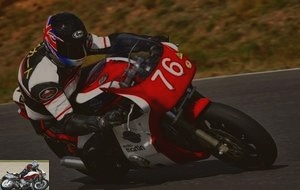 Agile and precise, the Moto Martin remains limited by its fork
Agile and precise, the Moto Martin remains limited by its fork
He did, however, use his decades of Superbike experience to perfectly set the Ohlins monoshock so that it smooths out most of the Broadford bumps and above all provides good handling in the last overhanging corner that hits the main straight. , then in the right uphill leading to the upper straight line. I honestly could feel the direct 1: 1 connection between my right hand and the rear tire, considered nirvana on current Superbikes and GPs. On a more humble level, the Moto Martin Kawasaki is too and part of that is due to the excellent rear suspension setup which surprised me with its efficiency despite the lack of a progressive rate linkage. I guess the presence of Ohlins is a big factor, but the fully linear power curve from 4,000 rpm is also a key.
 Conversely, the Цhlins rear suspension is perfectly adjusted.
Conversely, the Цhlins rear suspension is perfectly adjusted.
I had the opportunity to run the Z1000 engine in a race, in 1979 when I drove the P&M Kawasaki in the Tourist Trophy and in British TT Formula 1. OK, it was a less powerful 998cc engine but everything likewise pretty well built for me by Richard Pecket of P&M, whose Kawasaki beat the factory Honda Britain team to win the TT F1 title with John Cowie. I also rode John Page’s P&M Kwacker 1230 and remember that, while very torquey, it wasn’t as smooth an engine as the Moto Martin, once you get used to the idle of 2,000 rpm, defined to help the clutch counteract the inertia of the engine brake on heavy braking. In fact, Scott left quite a bit of engine braking in the setup, which helps the Brembo package to slow the bike down. It’s just as good as the Moto Martin brakes pretty much as I expected with the two-piston calipers: it’s okay but no marked bite. It is therefore necessary to use the fairly rigid gear lever on the left foot to obtain engine assistance, taking care not to let the Scitsu tachometer needle dance beyond the 9000 rpm mark. I used this brand to build up the gears. We thus find ourselves in the large torque zone from 6,500 to 7,500 rpm. The GPZ 1100 road gearbox does not have particularly close gears, but this has little impact considering the wide range of power and torque which develops smoothly and in a controllable manner from 4,000 rpm. / min.
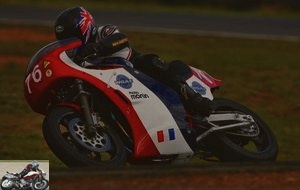 The motor offers a very linear and perfectly controllable power curve
The motor offers a very linear and perfectly controllable power curve
While this flexibility allowed me to experience a full turn of Broadford staying in third without even touching the clutch lever once, it’s not even the best feature of the Moto Martin’s engine package. The carburetor is perfectly tuned, especially on partial throttle, and results in ideal recovery out of bends, especially in slow bends inside Broadford. The Kawasaki engine’s response to the throttle isn’t just crisp and clean, it’s direct and responsive without being violent and so predictable that you dare to ask more and sooner from that meager rear tire that transmits 144 hp. from engine to asphalt.
 The 4-cylinder also shines with its great flexibility
The 4-cylinder also shines with its great flexibility
Conclusion
Aside from the primitive fork and the not-ideal braking response time, it’s hard to believe Scott Webster’s Martin Kawasaki Motorcycle was born in the 1970s. It looks a lot more like an early 1990s motorcycle in terms of maneuverability. While the engine doesn’t have as many horsepower as the 16-valve Suzuki and Honda it races against, it competes with a modern 600 supersport in terms of lap times on the Phillip Island circuit..
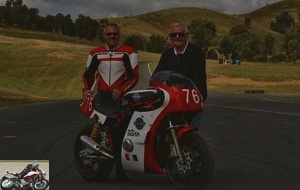 Scott and Bob Webster around the Martin Kawasaki 1230 Motorcycle
Scott and Bob Webster around the Martin Kawasaki 1230 Motorcycle
I think the Forgotten Era is a great class because people come to you all the time in the pits. You have a kind of relationship with the motorcycles of his youth and people like that because they are all different from each other. If you look at any Period 5 grid, you’ve got it all, pure variety. The recent new bikes are great, they are fast and the youngsters ride them well, but they are all the same. I think the Forgotten Era races are a lot more spectacular to watch, anyway, that’s what it feels like when you’re on the track. !
Strong points
- Maneuverability
- Engine availability
- Rear shock absorber
Weak points
- Fork
- Braking
The technical sheet of the Motorcycle Martin Kawasaki 1230
Related articles
-
Laverda 915 SFC motorcycle test
Post-classic queen 915 cc parallel-twin, 90 hp, steel subframe, 167 kg It’s been 20 years since the last Laverda left the brand’s factories, but the…
-
Kawasaki Z H2 Supercharged motorcycle test
200 hp, 14 mkg at 8,500 rpm, 239 kg all full, 17,099 € Put some salt ! Fifteen days of driving with the Kawasaki Z H2? I say it bluntly, it takes less to…
-
Offenstadt Kawasaki 750 sports bike test
The H2 Monocoque Pilot-engineers are a rare breed, especially those who are equally expert in both disciplines and able to design innovative and unique…
-
2012 Kawasaki ER-6n motorcycle test
New test: Kawasaki ER 6N: Sparkling with mischief ! Appeared in 2006 and restyled in 2009, the ER6 N gets a new facelift that makes it even sexier,…
-
Kawasaki Ninja ZX-10R KRT motorcycle test
An integer character 4 cylinders in line, 998 cm3, 203 hp, 114.9 Nm, 206 kg all full facts, 18,099 euros. Nice surprise for me to find the Kawasaki…
-
Kawasaki ER-6 N motorcycle test
A very stylish and punchy little urban The city of Mozart sounded for three days of a superb symphony in major exhaust. Orchestrated by Kawasaki making…
-
Kawasaki Z1B Moriwaki motorcycle test
Wild and brilliant roadster 4 cylinders in line, 1,135 cm3, 119 hp, 160 kg It has been exactly 40 years since New Zealander Graeme Crosby entered the GP…
-
Revelation 998 4-cylinder compressor, 998 cm3, 200 hp, 137 Nm of torque, 239 kg, 17,099 euros The Roadster era, a heated era in the motorcycle timeline,…
-
2009 Kawasaki ER-6n motorcycle test
3-day twin-cylinder roadster test The Kawasaki ER6n is Akashi’s twin-cylinder roadster initially introduced in 2005, which has achieved unprecedented…
-
Kawasaki Versys 1000 motorcycle test
La Z goes green Eternal absent from the Kawasaki range, apart from the unlikely KLV 1000 (Suzuki V-Str m renamed), the maxi-trail model finally appears…
Well, well, it’s done: V2 in the parking lot since last Saturday.
Just a little bit of a Chevreuse ride on Sunday to take it in hand before next weekend when I’m going to use it more intensely and on more varied terrain.